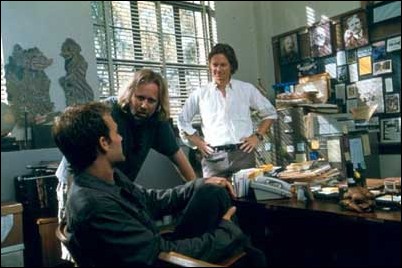An interview with Roger Avery

Image: An interview with Roger Avery:Photo courtesy of Lions Gate Films:
October 16, 2002
You may know him as a writer on perhaps the coolest movie of the 90’s: “Pulp Fiction.” But once upon a time, he was just a regular film-fanatic video clerk, whose co-worker was Quentin Tarantino.I had a few moments to converse with writer/director Roger Avary about his new feature, “The Rules of Attraction.”
Michelle Miller: The advertising I’ve seen thus far makes “Rules” look like a teen comedy when it’s more of an 80’s dark satire. Why the disparity?
Roger Avary: I can’t speak so much for the advertising. It seems as though they may be marketing it like an “American Pie” or something like that and you’re right, it’s definitely not that. I would caution against calling it an 80’s dark satire. It’s a dark satire, I actually extracted the 80’s part of it. I put a lot of 80’s music into it but I tried to make the movie temporally and spatially nonspecific. I also tried to make the movie really work for a multitude of audiences. I showed it to younger audiences and they seemed to really vibe on it and get into it and quite honestly whatever drags them into the theater… The people at Lion’s Gate have chosen to try to push it as a big, mainstream Hollywood [film]. I kind of fought that because it eases people going in, then when they go in, they’re sucker punched. But that’s fine with me because the movie is designed to sucker punch anybody, including an audience that’s prepared for it. So I support the approach that they have taken.
MM: Are you primarily a writer or a visual presenter?
RA: I only became a writer out of convenience, simply because it’s cheaper and easier to do it yourself than to try to explain to somebody else what you’re seeing. It’s your own material, you don’t have to pay anybody any money. Honestly it was economics that drove me into writing. Quentin [Tarantino] and I, we were buddies and we would write together. We wrote “Pulp Fiction” not really thinking that it would turn into what it turned into. It surprised us as much as anybody else. All of a sudden it’s the cultural barometer it became and to be perfectly frank with you my writing range went though the roof. I had been a starving filmmaker up until then and I did what any sensible person would do and I took the money and wrote, wrote, wrote. I gotta be honest with you, I’ve made about six movies already, I’ve just made them in my head, and the trick is now to make it so everybody else can see them.
MM: Why were you drawn to Brett Easton Ellis’ novel?
RA: I wrote the script without getting the rights to the book which, F.Y.I., you must never do. I wrote it because when I was in college, I was reading it and I’m just looking around and thinking, “This is exactly what I’m experiencing around me.” I would look up from the page and see the characters that were in the book wandering around. It was like, “I have to make this into a movie.” Cut to fifteen years later, I was thinking about it and I woke up one morning and it was like “I gotta write this and get it out of my head because it is haunting me.” So I sat down and hammered out the screenplay. I wrote it in a way that you actually should never write a screenplay. I described all the camera moves, what kind of motion control equipment I was going to need. I could certainly describe everything because I was just writing it for myself.I took great liberties with Brett’s work, but I tried to do what other people normally don’t do. I tried to capture spirit of the scene. The thing about Brett’s work is he’s so innovative stylistically and the literary devices are so rich that usually when they’re adapted to film, you have to throw away what I think is part and parcel to the scene. You throw those away and you’ve thrown away the pearl of the oyster in Brett’s work. And rather than shackle myself to trying to write an exact interpretation of the book, I just wrote the spirit of the book. My cinematic devices are a complement to his literary devices so you feel as if you are watching a book.
MM: One of those cinematic devices was filming scenes in reverse. Tell me a little about that.
RA: I always try to look for in-camera tricks, tricks that I can do because my budget is kind of low … [With the reverse-filming] I could actually sever the timeline and yet not allow that separation of time. To come back through and re-begin again, the scene is not mended. You’re not having to cut time, but be pulled back in time. That way the audience is lulled into believing that they’re watching one scene from three different angles opposed to three different moments in time. It seemed like the best way to show people who are in the exact same timeline. Perception is reality, people think of reality in different ways.
MM: I read that you had trouble with the MPAA and securing an R rating for the film. Did you have to cut anything?
RA: It doesn’t look like I cut out a lot, does it? The truth of the matter is there’s a lot of public awareness of my battle with the MPAA . I did not end up cutting that much. There are a couple moments of extreme content in the film, but in a lot of ways, there is very little you can actually see. [The MPAA] were concerned more about the morality of the film. They were afraid of a movie with all the sense of melancholy traveling out into the world in a mass way, and so they did their very best to prevent that. The way that you get to the MPAA is just time, you just take your time with them and you fight and you fight and you fight. It’s literally a battle of persistence. It comes down to wearing them down. A frame here, a frame there. The scene in the beginning of the film was so intense [the audience] was turning off and was unable to turn back on and re-engage for the rest of the movie. They were unable to reconnect with the film, and if that happens with your audience. you have completely failed because in doing that then you’re not able to engage them into relay your theme, you’ve failed to get your point across. I realized that by cutting a little out of that opening sequence it actually made the movie easier to handle. And yet I didn’t loose anything.
MM: Casting James Van Der Beek seems unusual given the roles he’s had in the past.
RA: At first I had the reaction that I think most people probably have. Somebody suggested James Van Der Beek, and I said, “Dawson?” The problem with being a TV actor on a very popular show [“Dawson’s Creek”] that’s been running for a long time is it’s very difficult for an audience to disengage. Like if you put Seinfeld into a movie, it’s hard for people to disengage, “That’s Seinfeld.” A friend of mine, Mark Romanek, made this movie “One Hour Photo” and had the same concern about Robin Williams. So I agreed to meet with James. He comes in and sits down and takes off his sunglasses. I look into his eyes and in that instant, in a fraction of a second, I immediately know he’s the guy because I see that dark emptiness which is exactly what the character needs. But he has something that a lot of the other actors didn’t have, a built-in likeability, kind of a puppy dog charisma and I knew it would be a valuable asset in keeping the audience. By casting James it suddenly became obvious that I should just open the floodgates and bring in Jessica Biel. I gotta tell you it was a perfect experience. I’ve never worked with another group of more dedicated, enthusiastic and professional people in my life.




























































































































